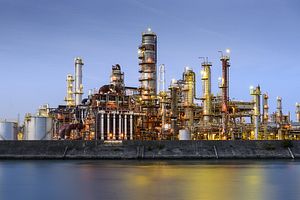Most commentary about the nuclear deal with Iran focuses on the implications for the region and U.S. allies in the Middle East and Europe. But it also removes a thorn in the side of the U.S.-Japan relationship. Tokyo’s role as a major importer of Iranian oil meant its cooperation was a key piece of the sanctions campaign against Tehran. Yet that cooperation did not come easy: it required repeated U.S. pressure and was a consistent cold spot in an otherwise warm U.S.-Japan relationship.
Japan is the third-largest oil importer in the world, behind only the United States and China. And for decades Iran was one of its key sources of crude oil – but the U.S.-driven sanctions campaign would change that. At its peak in 2003, Japan imported 17 percent of its crude petroleum from Iran. A year later, Japan’s state-backed energy group, INPEX, signed a contract with the National Iranian Oil Company (NIOC) to develop the Azadegan oil field and its estimated 36 billion barrels of oil. With every barrel from the field going straight to Japan, Azadegan alone was predicted to provide 6 percent of Japan’s oil imports each year.
With Japan’s interests and investments in Iran, Tokyo was reluctant to join the U.S. in its sanctions campaign, despite repeated and consistent pressure from American officials. Shinzo Abe, then Chief Cabinet Secretary in the Koizumi administration, doubted that sanctions would be effective. Without the broader concerted action desired by Japan, sanctions seemed only to endanger Japan’s own resource security at potentially little benefit. And worse, China could leap ahead of Japan in developing Iranian oil fields, potentially blocking Tokyo from future development projects.
However, containing Iran’s nuclear program through economic sanctions was a key U.S. priority. Japan was stuck between the rock of the U.S.-Japan alliance and the hard place of its own energy interests.
The Azadegan project, never liked by Bush administration officials, was the first casualty of the sanctions campaign. After Japan spent months trying to find a middle way – neither bowing to U.S. pressure nor proceeding with the Azadegan project – Iranian officials curtailed INPEX’s role, cutting its stake in the field from 75 percent down to a mere 10 percent. INPEX finally quit the project altogether in 2010. Making the loss even harder to swallow was who Iran turned to next: China’s state-owned China National Petroleum Corporation (CNPC), which promptly moved to fill the vacuum left by Japan’s absence.
As the sanctions campaign against Iran tightened in the 2010s, Japan once again came under pressure from the U.S.. Hoping to avoid a hard target for import cuts, Prime Minister Yoshihiko Noda signed off on new financial sanctions in December 2011, freezing assets of organizations and individuals linked to Iran.
This wasn’t enough. After several months of talks between U.S. and Japanese officials, a compromise emerged. Tokyo agreed to further reduce its oil imports from Iran, but was one of a select group of countries given waivers to continue importing some oil from Iran. The Secretary of State Hillary Clinton’s statement called Japan’s actions “especially noteworthy” in light of the “extraordinary energy and other challenges” facing Japan.
As Clinton acknowledged, Japan’s decision to cooperate with the U.S./EU sanctions campaign came at a difficult time for Tokyo: the 3/11 disaster and subsequent shutdown of Japan’s nuclear power plants put the need for energy imports front and center. But despite Japan’s need for energy, and its longstanding interests in Iran, sanctions had strong public backing. According to the 2012 Pew Global Attitudes survey, 94 percent of Japanese opposed Iran acquiring nuclear weapons, and six in ten of those opposed favored tougher international sanctions on Iran. That public support, and the repeatedly-renewed waivers exempting Japan from a total shutoff from Iranian oil, helped cushion the blow of Japanese participation.
The successful conclusion of the P5+1 talks with Iran, and the subsequent lifting of sanctions, has come as a relief to Japan. The end of the sanctions campaign has reopened Japanese investment opportunities in Iran, allowing Japanese firms to compete with their Chinese rivals. And earlier this month, Japanese foreign minister Fumio Kishida and Iran’s minister of economic affairs and finance Ali Tayybnia met in Tokyo to sign a bilateral investment agreement between the two nations.
It’s also possible that Japan will once again develop the Azadegan fields it lost in 2010. Although it looked as though China had beaten out Japan, Iran ejected CNPC from Azadegan in 2014 after repeated complaints from Tehran about slow development (CNPC was also ejected from the South Pars field in 2012).
Of course, the relationship between Tokyo and Tehran extends beyond their mutual oil interest. Japan has pledged to provide expertise on nuclear energy to Iran, including training on how to build earthquake-proof plants. Major Japanese businesses such as Suzuki and Nippon Steel & Sumitomo Metal are eager to revive dormant operations and tap into the Iranian market. As in countries throughout Southeast Asia, Japan will almost certainly compete with China to build high-speed rail in Iran. And a trip to Tehran may even be on Prime Minister Abe’s agenda.
While U.S.-Japan relations were likely not foremost in the minds of the P5+1 negotiators in Vienna, the deal has nonetheless removed a serious source of tension in the U.S.-Japan alliance. With so many other issues on the U.S.-Japan agenda – tensions in the South China Sea, North Korean nuclear activity, and the continuing fight over the Futenma Replacement Facility – it is no doubt a relief to policymakers on both sides to cross one item off the list.
Craig Kafura is research associate for public opinion and foreign policy at the Chicago Council on Global Affairs. He holds an MA from Columbia University and a BA from Yale University. The views expressed here are his own. Follow him online @ckafura.

































